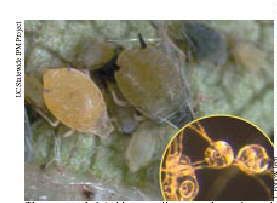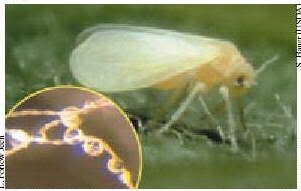Cotton Stickiness occurs when excessive sugars present on fibers are transferred to equipment and interfere with processing. Sugars may be insect- or plant-derived.
Though sugars are ubiquitous in lint, they usually occur at levels that pose no processing difficulties. This details the sources and components of problem sugars on harvested lint, the processing impacts of stickiness, and strategies for avoiding or mitigating stickiness.
Cottons contaminated with stickiness cause multiple problems in the spinning mills. The honeydew present on the cotton lint is able to contaminate all the mechanical instruments used in the transformation process from fiber to yarn, i.e. opening,carding, drawing, roving and spinning operations. These contaminants are mainly sugar deposits produced either by the cotton plant itself (physiological sugars) or by the feeding insects (entomological sugars), the latter being the most common source of contamination.
Honeydew, when present in sufficient quantity, is the main source of sugars that can result in sticky lint. Honeydew is excreted by certain phloem-feeding insects including such common pests of cotton as aphids and whiteflies. These insects are capable of transforming ingested sucrose into over twenty different sugars in their excreted honeydew. The major sugars in cotton insect honeydew are trehalulose, melezitose, sucrose, fructose and glucose.
Another source of stickiness is free plant sugars sometimes found in immature fibers. Cotton fiber is largely cellulose that is formed from sugars synthesized by the plant. Dry, mature cotton fibers contain little free sugar, while immature cotton fibers contain glucose, fructose, sucrose, and other sugars. If immature cotton fiber is subjected to a freeze, complex sugars may be broken down to release additional simple sugars. Less commonly, oils released by crushed seed coat fragments can also result in stickiness. In this case, raffinose is the characteristic sugar.
Sugars differ in their stickiness. For example, sucrose, melezitose, and trehalulose are all significantly stickier when deposited on fiber than are glucose or fructose. Further, trehalulose-contaminated fiber is stickier than fiber with an equivalent amount of melezitose. Mixtures of sugars, such as occur in honeydew, tend to be stickier than single sugars. Localized concentration of sugars like honeydew is at higher risk of causing stickiness than more evenly distributed sources like plant sugars.
Sticky cotton can reduce cotton gin output (in bales/hr) by up to 25%. At the textile mill, excessive wear and increased maintenance of machinery may occur even with slightly sticky cotton. In severe instances mill shutdown with a thorough cleanup is required.
COTTON APHIDS:
Aphids are slow-moving, soft-bodied insects. Adult cotton aphids are approximately 1/10 of an inch long and roughly pear shaped. They may possess wings or may be wingless. Cotton aphids have two color phases: yellowish or dark green.
The cotton aphid has two projections which arise from the upper side of the abdomen. These small tubes are called cornicles and are used to excrete defensive secretions.
Both the adult and immature stages (called nymphs) of the cotton aphid have stylet like mouthparts, which they use to suck juices from the host plant. Consequently, cotton aphids are sometimes referred to as plant lice
FIG:cotton Aphid

The cotton aphid, Aphis gossypii, excretes honeydew rich in melezitose (ca. 30–40%). Their droplets (inset, 50X) tend to be larger than those produced by whiteflies.
FIG: Whitefly

Whiteflies, Bemisia spp., also excrete honeydew, but as trehalulose-rich (ca. 40–50%) droplets (inset, 50X).
STICKINESS MEASUREMENT:
‘Stickiness’ is the physical process of contaminated lint adhering to equipment . The degree of stickiness depends on chemical identity, quantity, and distribution of the sugars, the ambient conditions during processing—especially humidity —and the machinery itself. Stickiness is therefore difficult to measure.
Nonetheless, methods for measuring sugars on fiber have been and are being developed. These measurements may be correlated with sticking of contaminated lint to moving machine parts. The physical and chemical attributes of the lint and sugars that are correlated with stickiness have been measured in many ways, each with differing efficiency and precision.REDUCING SUGAR METHOD:
Some textile mills use reducing-sugar tests based on reduction of the cupric ion to screen for sugar contamination. These tests are relatively quick and inexpensive. However, some insect sugars are not reducing sugars, and some others are measured at different levels of efficiency by various reducing-sugar methods. Thus conventional reducing-sugar tests are best reserved for screening lint that potentially has high levels of plant sugars. In these cases and with the potassium ferricyanide (KFeCN) test, lint with reducing sugar levels below 0.3% may be processed without difficulty.
HIGH PERFORMANCE LIQUID CHROMATOGRAPHY:
High Performance Liquid Chromatography (HPLC) identifies and measures both reducing and nonreducing sugars. The main sugars of insect honeydew, trehalulose (from whiteflies) and melezitose (from aphids), and of plant sugars (glucose, fructose & sucrose) are all readily identified in this test. The benefit of HPLC analysis is the identification of the source of contamination (whitefly, aphid, or plant) which may help identify specific mitigiation measures
MINICARD METHOD:
The physical interaction of all sugars on lint with equipment can be measured by several types of machines. The primary difficulty with these physical tests is in standardizing the stickiness measurement. As with chemical testing, these tests must be correlated with measures of fiber processing efficiency in order to interpret the results. One of these tests, the minicard, is a physical test that measures actual cotton stickiness of the card web passing between stainless steel delivery rollers of a miniature carding machine. Modeled after a production carding machine, the minicard must be run under strict tolerances. A ‘0’ minicard rating indicates that no sticking was observed, while progressively higher numbers (on a 0–3 scale) indicate progressively greater amounts of sticking during the process. Cottons with high plant sugar contents evenly distributed along the fibers may fail to be measured as sticky in this test. The minicard test is slow and has been replaced as the international standard by the manual thermodetector.
STICKY COTTON THERMODETECTOR:
The Sticky Cotton Thermodetector (SCT) measures the physical sticking points transferred to aluminum sheets by a conditioned lint sample that is squeezed and heated (to 82.5°C for 12 sec.). Levels of stickiness are categorized according to the number of specks left on the two sheets of foild.Lower numbers of specks are preferable to higher numbers; however, a specific threshold over which all cotton will result in processing problems has not been defined. The SCT takes about 5 minutes to process each sample, requires smaller initial investment costs than the minicard, is more mobile, and its results correlate well with predicted stickiness from the minicard.
HIGH SPEED STICKINESS DETECTOR:
The High Speed Stickiness Detector (H2SD) is a quicker, automatic version of the thermodetector. The cotton sample is pressed between a heated (54°C for 30 sec.) and an unheated pressure plate. Sticky points are counted and point size distribution determined by image-processing computer software. Plates are automatically cleaned between samples. The H2SD is able to analyze a sample in 30 seconds.
FIBER CONTAMINATION TESTER:
Like the thermodetector and H2SD, the Fiber Contamination Tester (FCT) measures physical sticking points (at 65% RH). The instrument feeds a thin web between two rollers. Contamination of the rollers interrupts a laser beam, resulting in a recording. Because the cleaning and recording is automated, samples may be processed as quickly as one per 45 seconds.
While there is no reliable infield method for detection of stickiness predisposition, the insects responsible for honeydew deposits can be sampled and populations measured. Not all population levels of insects lead to sticky lint; however, chronic numbers of insects, especially during boll opening or an extended season, can lead to excessive insect sugars that result in stickiness. In addition, field factors associated with risk of excessive plant sugars are lateness of the crop, fiber immaturity, and freezing temperatures before harvest.
STICKINESS CONTROL:
The most efficient way now to prevent stickiness is by managing sugar sources in the field. Detailed integrated pest management plans (see references) for both aphid and whitefly. These honeydew-producing insects may be managed by avoiding conditions leading to outbreaks, carefully sampling pest populations, and using effective insecticides when populations reach predetermined thresholds.
The risk of having excessive plant sugars can be minimized by harvesting mature seed cotton. This may be accomplished through plant management tactics that include: early and uniform planting, nitrogen management according to plant growth and yield goals, high first-position boll retention, and timely chemical termination and harvest.
If a freeze is imminent and immature bolls are present, the use of boll-opening chemicals can greatly diminish the problem of plant sugar contamination. All these measures work towards early harvest, before freezing conditions that contribute to excess plant sugars.MITIGATING THE PROBLEM:
When field management of sugar sources is inadequate to prevent excess accumulation of sugars, mitigation tactics may be necessary to remove excess sugars from the lint. This mitigation may be achieved through both natural and managed processes; however, the specific impact of these processes on stickiness is variable and may depend on the initial level of contamination.
Natural processes include weathering, rainfall, and degradation by microorganisms. Since sugars are water soluble, rainfall will wash some honeydew from lint. If sufficient moisture is available, bacteria and molds living on the plants will decompose many honeydew sugars. Complex sugars are broken down to simpler sugars, and the simpler sugars, given sufficient time and moisture, are further broken down to carbon dioxide and water. Unfortunately, microbial action also leads to discoloration and to a weakening of the fibers as well as heating of cotton in modules that may result in reduced seed viability and problems in ginning.
Potential in-field mitigation techniques include supplemental oversprays of enzymes or water. Certain carbohydrate degrading enzymes when sprayed on sticky cotton can reduce honeydew to simpler sugars. Microbial activity on the fibers then further degrades these simpler sugars, resulting in a significant decrease in fiber stickiness. However, these enzymes require water for activity, and metering the proper amount of water for activity is a problem yet to be solved. In some areas of the world, overhead and in-canopy irrigation has been used to remove honeydew from open bolls. The frequency of this type of irrigation may be more important than the volume applied. Use of sprinklers has been limited in the Western United States, where furrow irrigation is prevalent.
If stickiness is a problem while ginning, the ginning rate of honeydew contaminated cotton can be increased by increasing the heat of the drying towers to reduce humidity. The potential for stickiness can be further reduced by lint cleaning. Both of these practices, however, can result in shorter fibers.
Conventional textile lubricants may also be used. Stickiness due to high levels of plant sugars can be reduced by storing the cotton for approximately six months.
However, storage of baled cotton will not appreciably reduce stickiness from insect sugars. At the textile mill, stickiness may be managed by blending bales and by reducing humidity during carding.
A lubricant in fog form may be introduced at the end of the hopper conveyor, and cardcrush rolls may be sprayed sparingly with a lubricant to minimize sticking.
REFERENCE:
THE ABOVE INFORMATION IS FROM THE UNIVERSITY OF ARIZONA PUBLICATION ON COTTON STICKINESS,